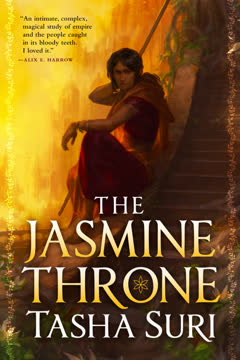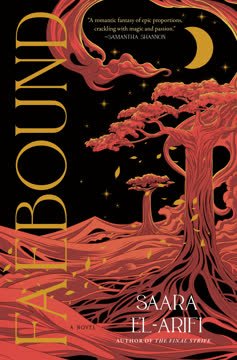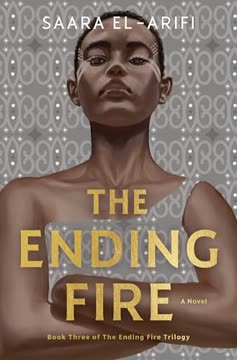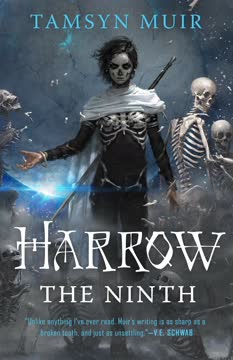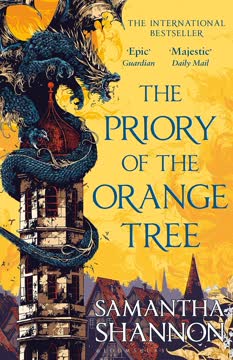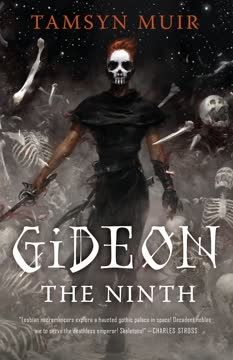Plot Summary
Pyres and Poisoned Thrones
The Jasmine Throne opens with a pyre: Emperor Chandra, obsessed with purity and faith, orders his sister Malini and her handmaidens to burn for supposed impurity and treason. Malini refuses, setting the stage for her imprisonment and the empire's descent into religious tyranny. The burning of women is both a literal and symbolic act, establishing the violence and control at the heart of Parijatdvipa's rule. The empire is fractured, with Ahiranya—a conquered, restive province—simmering with rebellion and rot, a magical blight that infects both land and people. The pyre is not just a punishment, but a tool of power, and the threat of fire haunts every woman in the story.
Maidservant in the Shadows
In the city of Hiranaprastha, Priya is a maidservant in the regent's household, but her past is a secret: she is a survivor of the temple children, once destined for power, now hiding in plain sight. She risks her safety to help the poor and rot-riven, buying sacred wood to slow the magical disease. Her compassion is matched by a fierce, hidden strength, and her memories of the temple and her lost siblings are fragmented and painful. Priya's world is one of hunger, fear, and small acts of resistance, but she is drawn inexorably back toward the magic and violence she tried to escape.
The Princess Imprisoned
Malini, the emperor's sister, is sent to Ahiranya as a political prisoner, locked in the ruined temple of the Hirana. Drugged with needle-flower, isolated, and watched by her jailer Pramila, Malini's mind is clouded, but her will is unbroken. She is haunted by the deaths of her friends and the threat of the pyre, but she plots escape and revenge. Her intelligence and ruthlessness are sharpened by suffering, and she seeks allies among the servants, especially Priya, whose strength she glimpses through the cracks of her own despair.
Sacred Wood and Rot
The rot is both a literal disease and a metaphor for the empire's corruption. Sacred wood, the only thing that slows the rot, is scarce and costly, and Priya's efforts to help the afflicted bring her into contact with the city's underbelly and her own past. The forest is alive with magic, and the boundaries between healing and harm, power and vulnerability, are blurred. The rot's spread is tied to the empire's violence against Ahiranya, and the search for a cure becomes a quest for justice and self-knowledge.
The Hirana's Secrets
The Hirana, once the seat of Ahiranya's magical power, is now a prison and a grave. Priya and other maidservants are tasked with maintaining it, and the climb up its treacherous surface is both a physical and spiritual ordeal. The temple's carvings and hidden chambers are alive with memory and magic, and Priya's connection to the Hirana deepens as she risks herself to save others. The boundaries between past and present, living and dead, are porous, and the temple's secrets call to those who have lost everything.
Rebellion in the Forest
In the forests beyond the city, Ashok—Priya's lost brother—leads a band of rebels, former temple children and their followers, using violence and magic to strike at the empire. The rebels are fractured by desperation and the poison of the deathless waters, which grant power but bring death. Ashok's vision of a free Ahiranya is uncompromising, and his willingness to sacrifice others—including Priya—sets him on a collision course with his sisters and the future of the kingdom.
Sisters of Fire and Water
Bhumika, the regent's wife and another survivor of the temple, navigates the treacherous politics of the household, protecting orphans and rot-riven, and using her influence to shield the vulnerable. Her marriage to Vikram, the regent, is both a political alliance and a source of pain, as she balances loyalty to her family, her people, and her own survival. Bhumika's power is subtle but profound, and her choices shape the fate of Ahiranya as much as any act of open rebellion.
The Deathless Waters
The deathless waters, hidden beneath the Hirana, are the source of Ahiranya's magic and the key to both healing and destruction. Priya's journey to the waters is a journey into memory, pain, and power. To enter the waters is to be hollowed out, remade, and given gifts that can save or destroy. The waters demand sacrifice, and those who survive are changed forever. The quest for the waters brings Priya, Ashok, and Bhumika into confrontation with their past, their family, and the future of their people.
Masks and Betrayals
The story is rife with secrets: Priya's true identity, Malini's ambitions, Ashok's plans, and the hidden loyalties of servants, rebels, and nobles. Masks—literal and figurative—are worn by all, and betrayals are inevitable. The burning of the city, the assassination attempts, and the shifting allegiances of the highborn and the rebels all culminate in a night of fire and blood, where the cost of power is revealed and the lines between friend and enemy blur.
The Poisoned Cup
Poison is both a weapon and a prison: Malini's mind is clouded by the drug, and her survival depends on Priya's intervention. The struggle to control the dosage, to resist Pramila's cruelty, and to reclaim agency is a battle fought in the body and the soul. The poisoned cup is a symbol of the ways women are controlled, silenced, and sacrificed, and the fight to survive is as much about reclaiming the self as it is about escaping physical captivity.
The Burning of Hiranaprastha
The rebels, empowered by the deathless waters and driven by desperation, attack the city, burning the homes of the powerful and shattering the fragile peace. The regent is overthrown, the palace is besieged, and the old order collapses in fire and blood. Bhumika, Priya, and the survivors must choose between vengeance and mercy, and the cost of freedom is paid in lives and dreams. The burning is both an ending and a beginning, as the survivors claim power and set the stage for a new world.
The Price of Power
The survivors of the deathless waters—Priya, Bhumika, and a handful of rebels—emerge changed, bearing the weight of new magic and new responsibilities. Ashok's death is both a personal and political loss, and the question of who will lead Ahiranya is answered in the coronation of Bhumika as elder, with Priya at her side. The price of power is steep: family, innocence, and the possibility of a simple life are all lost, and the future is uncertain.
The Hollowing
To be hollowed by the waters is to be remade, to lose and gain in equal measure. Priya's journey is one of self-discovery and self-sacrifice, as she learns to wield her power for healing rather than destruction. The hollowing is both a blessing and a curse, and the struggle to remain human in the face of magic and violence is at the heart of the story. The survivors must decide what kind of world they will build, and what they are willing to give up to save it.
The Empress Crowned
In the aftermath of the burning, Malini claims the throne, using prophecy, politics, and sheer will to unite the lords and princes of Parijatdvipa behind her. Her coronation is both a triumph and a tragedy, as she embraces the monstrousness required to rule and vows to destroy her brother Chandra. The cost of power is the loss of innocence, and the crown is both a weapon and a burden.
The Cure and the Crown
As Bhumika and Priya take up the mantle of leadership in Ahiranya, they turn their power toward healing: curing the rot, protecting the vulnerable, and forging alliances that may one day bring true freedom. Malini, now empress, is both ally and potential enemy, and the future is uncertain. The story ends with the promise of reunion, the hope of a better world, and the knowledge that the struggle for justice and selfhood is never truly over.
Characters
Priya
Priya is the heart of the novel: a former temple child hiding as a maidservant, haunted by trauma and loss. Her compassion for the rot-riven and the vulnerable is matched by a fierce, sometimes violent strength, and her journey is one of reclaiming power and memory. Priya's relationships—with her siblings Ashok and Bhumika, with the orphan Rukh, and with Malini—are fraught with love, betrayal, and longing. She is shaped by guilt and hope, and her development from a self-effacing servant to a twice- and then thrice-born leader is both painful and triumphant. Priya's magic is both a gift and a curse, and her struggle to use it for healing rather than destruction is the novel's central arc.
Malini
Malini is the emperor's sister, a political prisoner whose mind and body are battered by poison and isolation. Her intelligence, ruthlessness, and capacity for both love and manipulation make her a formidable protagonist. Malini's relationships—with her dead friends, her jailer Pramila, her brother Aditya, and especially Priya—are complex and shifting. She is driven by a desire for justice and vengeance, but also by a hunger for power and self-determination. Her rise from captive to empress is marked by sacrifice, monstrousness, and the loss of innocence, and her love for Priya is both a source of strength and vulnerability.
Ashok
Ashok is Priya's lost brother, a leader of the Ahiranyi rebels, driven by rage, trauma, and a vision of a free homeland. His willingness to use violence, to sacrifice others, and to consume the deathless waters despite their cost makes him both a hero and a villain. Ashok's relationship with Priya is fraught with love, betrayal, and the legacy of their shared suffering. His death is both a personal tragedy and a turning point for the rebellion, and his legacy haunts the survivors.
Bhumika
Bhumika, the regent's wife and another temple survivor, is a master of subtlety and survival. Her marriage is both a shield and a prison, and her loyalty to her people is unwavering. Bhumika's strength is in her ability to navigate politics, protect the vulnerable, and wield power without drawing attention. Her relationship with Priya is sisterly but complicated by guilt, rivalry, and love. As the new elder of Ahiranya, Bhumika embodies the possibility of healing and hope.
Rukh
Rukh is a rot-riven orphan whom Priya saves and brings into the regent's household. His innocence, bravery, and longing for belonging make him both a victim and a participant in the rebellion. Rukh's journey from spy to loyal follower mirrors Priya's own struggle for selfhood and redemption, and his survival is a testament to the possibility of change.
Pramila
Pramila is Malini's jailer, a highborn woman whose grief and fanaticism make her both pitiable and terrifying. Her relationship with Malini is shaped by loss, resentment, and the legacy of the pyre. Pramila's cruelty is a reflection of the empire's violence against women, and her eventual defeat is both a personal and political victory.
Emperor Chandra
Chandra is the emperor of Parijatdvipa, obsessed with purity, faith, and control. His willingness to burn his own sister and to use violence as a tool of power makes him the novel's central antagonist. Chandra's actions set the plot in motion, and his shadow looms over every character's choices.
Aditya
Aditya, Malini's brother, is the rightful heir to the throne but has renounced power for faith. His passivity and indecision are both a source of frustration and a commentary on the burdens of leadership. Aditya's relationship with Malini and Rao is marked by love, disappointment, and the weight of prophecy.
Rao
Rao is a prince of Alor, Malini's ally and Aditya's friend. His secret name and prophetic destiny tie him to the fate of the empire, and his loyalty is both a strength and a burden. Rao's grief for his sister and his love for Malini shape his actions, and his role as kingmaker is central to the novel's climax.
Kritika
Kritika is a former pilgrim and Ashok's most loyal follower. Her willingness to sacrifice herself for the cause, her care for the dying, and her eventual alliance with Bhumika and Priya make her a symbol of the costs and possibilities of rebellion.
Plot Devices
Dual Protagonists and Interwoven Narratives
The novel alternates between Priya and Malini, whose stories mirror and diverge as they navigate captivity, trauma, and the quest for agency. Their relationship is the emotional core of the book, and their choices shape the fate of kingdoms. The interwoven narratives allow for deep exploration of power, gender, and resistance, and the convergence of their arcs is both inevitable and surprising.
Magic as Metaphor and Weapon
Magic in The Jasmine Throne is both a literal force and a metaphor for trauma, healing, and transformation. The rot is a disease born of violence and oppression, and the quest for a cure is a quest for justice. The deathless waters are a source of power that demands sacrifice, and the hollowing is both a magical and psychological process. Magic is used for healing and harm, and the struggle to wield it responsibly is central to the plot.
Masks, Secrets, and Betrayals
The novel is structured around secrets: hidden identities, shifting allegiances, and the masks people wear to survive. Betrayals—personal and political—are inevitable, and the revelation of truth is both dangerous and liberating. The use of literal masks by the rebels, and the figurative masks worn by all, underscores the themes of selfhood and deception.
Political Intrigue and Rebellion
The Jasmine Throne is a story of revolution: the burning of the city, the overthrow of the regent, and the rise of new leaders. The political machinations of nobles, rebels, and servants are as important as battles and magic, and the struggle for power is both personal and collective. The novel uses foreshadowing, shifting alliances, and the slow unraveling of the old order to build tension and drive the plot.
The Price of Power and the Hollowing
The central plot device is the idea that power demands a price: to be hollowed by the waters, to lose family, to become monstrous. The transformation of Priya, Malini, and others is both magical and psychological, and the struggle to remain human in the face of violence and ambition is the novel's deepest theme.
Analysis
The Jasmine Throne is a lush, complex fantasy that interrogates the nature of power, trauma, and resistance through the intertwined stories of two women—Priya, a healer haunted by loss, and Malini, a princess determined to seize her fate. Drawing on South Asian history and myth, Tasha Suri crafts a world where magic is both a blessing and a curse, and where the struggle for justice is inseparable from the struggle for selfhood. The novel explores the costs of power—how women, queers, and the colonized must hollow themselves to endure, and how reclaiming power means embracing both monstrousness and vulnerability. Through its nuanced characters, intricate politics, and evocative prose, The Jasmine Throne offers a meditation on the price of power, the possibility of healing, and the hope that even in a world built on ashes, something new can bloom.
Last updated:
FAQ
0. Synopsis & Basic Details
What is The Jasmine Throne about?
- A Princess's Desperate Bid: The Jasmine Throne follows Princess Malini, imprisoned by her zealous brother Emperor Chandra for refusing to burn on a pyre. Exiled to the conquered province of Ahiranya, she plots her escape and revenge, seeking allies to depose Chandra and place her reluctant elder brother, Aditya, on the throne.
- A Maidservant's Hidden Power: In Ahiranya, Priya is a maidservant concealing a powerful past as a temple child, a survivor of a massacre that destroyed her family and suppressed her magic. She secretly aids the rot-riven, a magical blight afflicting her people, while grappling with fragmented memories and a burgeoning connection to the ancient Hirana temple where Malini is imprisoned.
- An Empire's Fractured Heart: The narrative weaves together their stories as Malini and Priya form an unlikely alliance, navigating political intrigue, a burgeoning rebellion led by Priya's lost brother Ashok, and the rediscovery of ancient magic. Their intertwined journeys explore themes of power, trauma, and resistance against a backdrop of a South Asian-inspired empire on the brink of war.
Why should I read The Jasmine Throne?
- Rich, South Asian-Inspired Fantasy: Dive into a world brimming with intricate cultural details, lush descriptions, and a unique magic system rooted in nature and ancient lore, offering a refreshing alternative to traditional Western fantasy settings. The novel's setting in Parijatdvipa and Ahiranya provides a vibrant backdrop for its complex narrative.
- Complex, Morally Gray Female Leads: Experience a story driven by two formidable women, Malini and Priya, whose motivations are deeply nuanced, often blurring the lines between hero and anti-hero. Their evolving relationship, from wary allies to passionate lovers, forms the emotional core of the book, exploring themes of queer identity and female agency.
- Deep Exploration of Power and Trauma: Tasha Suri masterfully delves into the psychological impact of oppression, religious fanaticism, and personal loss. The magic system itself, particularly the "deathless waters" and the "hollowing," serves as a powerful metaphor for the sacrifices required to gain and wield power, making for a thought-provoking read.
What is the background of The Jasmine Throne?
- A Conquered Nation's Legacy: The story is set in Parijatdvipa, an empire founded by the Mothers of Flame, whose sacrificial deaths ended the Age of Flowers and subjugated the yaksa-worshipping Ahiranyi. Ahiranya, now a restive province, carries the bitter history of its defeat, its culture suppressed, and its people suffering from the 'rot,' a magical blight.
- Religious and Political Strife: Emperor Chandra's reign is marked by extreme religious zeal, demanding purity and sacrifice, particularly from women, and consolidating power in Parijati hands. This contrasts sharply with the ancient Ahiranyi faith centered on yaksa spirits and the nameless god worshipped by Alorans and Srugani, creating deep political and cultural fault lines across the empire.
- The Hirana's Ancient Power: The Hirana temple in Ahiranya, once a seat of immense magical power and home to the temple children, was destroyed by Chandra's father, Emperor Sikander. Its ruins now serve as Malini's prison and a potent symbol of Ahiranya's lost glory, holding secrets of the "deathless waters" and the suppressed magic that Priya and her siblings once wielded.
What are the most memorable quotes in The Jasmine Throne?
- "My brother, I will not forget." (Malini, Prologue): This chilling declaration, spoken by Malini to Chandra as he attempts to force her onto a pyre, encapsulates her unwavering resolve for vengeance and sets the tone for her ruthless pursuit of power throughout the novel. It highlights her deep-seated trauma and commitment to defying her brother.
- "You're lucky, that I am not what I was raised to be." (Priya, Chapter 1): Priya's internal thought after being shoved in the market reveals her suppressed strength and violent past as a temple child. It foreshadows her latent power and the constant internal struggle between the person she was trained to be and the compassionate maidservant she has become.
- "I am still what I have always been." (Malini, Chapter 52): Malini's defiant assertion to Pramila, even while imprisoned and poisoned, underscores her core identity and resilience. It speaks to her unyielding nature and her refusal to be broken or redefined by her captors, hinting at the hidden depths of her ambition and self-knowledge.
- "I'm strong enough not to need to." (Priya, Chapter 70): Priya's response to Malini's challenge about hurting her, even to save herself, reveals her unique understanding of strength. It signifies her evolution beyond brute force, embracing a power rooted in compassion and self-control, and her commitment to a different path than Ashok's.
What writing style, narrative choices, and literary techniques does Tasha Suri use?
- Lyrical and Sensory Prose: Suri employs rich, evocative language that immerses the reader in the world of Parijatdvipa and Ahiranya, particularly through sensory details of scent (jasmine, smoke, rot), touch (wet stone, burning wood), and sight (colors of saris, glowing magic). This creates a deeply atmospheric and often visceral reading experience, enhancing the emotional impact of the narrative.
- Dual Protagonists and Interwoven Narratives: The story alternates between Priya and Malini's perspectives, offering deep insight into their individual psychologies, motivations, and internal conflicts. This narrative choice fosters empathy and allows for a nuanced exploration of their evolving relationship, highlighting their unspoken thoughts and desires, which are often at odds with their outward actions.
- Subversion of Fantasy Tropes and Symbolism: Suri reworks traditional fantasy elements, such as "chosen one" narratives and magical diseases, to explore themes of colonialism, queer identity, and female agency. The "rot" is not just a blight but a metaphor for systemic oppression, while the "deathless waters" offer power at a profound personal cost, challenging simplistic notions of good and evil.
1. Hidden Details & Subtle Connections
What are some minor details that add significant meaning?
- Priya's Kitchen Knife as a Symbol of Latent Power: Initially presented as a mundane tool for a maidservant, Priya's finely honed kitchen knife subtly foreshadows her suppressed combat skills and capacity for violence. When she later uses it to carve sacred wood or threatens Gautam, it highlights the stark contrast between her unassuming exterior and the deadly abilities she possesses, revealing her constant internal battle with her past as a temple child.
- Malini's Neck Scar and Chandra's Early Cruelty: The "faint tracery of silver, curved like a sickle moon" on Malini's neck (Chapter 38) is a subtle detail that later gains profound significance when she recalls Chandra cutting her hair as a child. This seemingly minor scar symbolizes Chandra's long history of psychological and physical abuse, establishing his monstrous nature and Malini's deep-seated trauma long before his more overt acts of tyranny.
- The Hirana's Living Carvings: The temple's grotesque carvings of coiled snakes, mortal bodies, and yaksa with "eyes that oozed greenery" (Chapter 13) are more than mere decoration; they are a living record of Ahiranya's history and a manifestation of the Hirana's inherent magic. Priya's ability to feel the stone "heave, like the vertebrae of a great, sleeping beast" (Chapter 17) hints at the temple's sentience and its deep connection to her own dormant powers.
What are some subtle foreshadowing and callbacks?
- Rukh's Ominous Warning to Priya: Rukh's earnest plea, "Please. Don't go up the Hirana this week" (Chapter 24), subtly foreshadows the danger Priya faces from Meena and the rebels. His guilt-ridden expression hints at his knowledge of the impending attack, revealing the rebels' infiltration of the mahal and their awareness of Priya's unique connection to the Hirana, even before Priya fully understands it herself.
- Malini's "Impurity" and Queer Identity: Chandra's initial condemnation of Malini for being "unwomanly" and "impure" (Prologue) subtly foreshadows her queer identity and her rejection of patriarchal expectations. This early judgment sets the stage for her later confession of desiring women and her refusal to conform to traditional roles, revealing that her "impurity" is not just political treason but a deeper challenge to societal norms.
- Aditya's Catur Game and Prophetic Foresight: Aditya's childhood habit of removing the king piece from the catur board, stating "Now the king can contemplate the distant horizon. Much more fun than war" (Chapter 66), subtly foreshadows his later reluctance to embrace the throne. This seemingly innocent detail reveals his inherent desire to avoid the burdens of power, a trait that Malini must later confront and manipulate to achieve her goals.
What are some unexpected character connections?
- Gautam's Secret Alliance with Ashok: The revelation that Gautam, the gruff apothecary, has been supplying Ashok with bottled deathless waters (Chapter 43) is an unexpected twist. It highlights Ashok's early ruthlessness in leveraging fear and old debts, and reveals a hidden network of support for the rebellion that extends beyond obvious sympathizers, complicating Priya's understanding of her brother's methods.
- Lata's Scholarly Link to Malini's Mother: Lata, the sage accompanying Rao, reveals that her teacher educated Malini's sister and that she herself was "family of a kind, in scholarship" (Chapter 44) to Malini's royal circle. This connection subtly positions Lata as an intellectual ally and a bridge to Malini's past, showing that Malini's mother secretly fostered her daughters' education in strategy and philosophy, subverting the expected roles for royal women.
- Commander Jeevan's Hidden Loyalty to Bhumika: The discovery that Commander Jeevan, the regent's loyal guard captain, is secretly devoted to Bhumika (Chapter 61) is a significant revelation. It demonstrates Bhumika's profound influence and strategic foresight, as she cultivated loyalty among key figures in the mahal, creating a hidden power base that ultimately enables her to overthrow Vikram and protect Ahiranya.
Who are the most significant supporting characters?
- Sima, the Steadfast Friend: Priya's fellow maidservant, Sima, serves as a crucial emotional anchor and a representation of ordinary life. Her unwavering friendship, practical support, and willingness to risk herself for Priya (e.g., saving her work, offering to check on Rukh, hugging her fiercely after her return) highlight the importance of human connection amidst political turmoil and personal trauma. Sima's character grounds Priya's journey in relatable human experience.
- Kritika, the Dedicated Rebel: Ashok's most loyal follower, Kritika, embodies the fierce dedication and tragic sacrifices of the Ahiranyi rebellion. Her unwavering faith in Ashok's vision, her willingness to consume the poisoned waters, and her final act of giving Ashok the last vial (Chapter 65) underscore the desperate stakes of their fight for freedom and the profound personal cost of their cause.
- Lord Govind, the Cynical Elder: Bhumika's ailing uncle, Lord Govind, represents the older generation of Ahiranyi highborn who have witnessed the empire's oppression and the futility of open rebellion. His weary wisdom and cautious approach to resistance ("Dreams are dreams," Chapter 44) provide a contrasting perspective to Ashok's zealotry, highlighting the diverse forms of Ahiranyi defiance and the long memory of their subjugation.
2. Psychological, Emotional, & Relational Analysis
What are some unspoken motivations of the characters?
- Chandra's Insecurity Driving His Cruelty: Emperor Chandra's obsessive pursuit of "purity" and his brutal punishments, particularly towards women, are implicitly driven by a deep-seated insecurity about his own legitimacy and power. His need to control Malini, even to the point of forcing her to burn, stems from a desire to assert absolute dominance and erase any challenge to his authority, reflecting a fragile ego masked by religious fervor.
- Priya's Desire for Agency Beyond Survival: While Priya explicitly states her desire for "coin" to help others, her deeper, unspoken motivation is a yearning for agency and self-determination, a desire to reclaim the power and identity stolen from her. Her initial self-effacement is a survival mechanism, but her increasing willingness to use her magic and challenge authority reveals a profound hunger to shape her own destiny and that of her people, rather than merely endure.
- Malini's Calculated Vulnerability: Malini's moments of apparent weakness, such as her feigned collapse before Vikram or her tearful confessions to Priya, are often calculated acts of manipulation. Her unspoken motivation is to exploit others' pity or compassion to gain allies and advance her political agenda, demonstrating her ruthless pragmatism and her mastery of emotional warfare in a world where overt power is denied to her.
What psychological complexities do the characters exhibit?
- Aditya's Moral Paralysis by Faith: Aditya, Malini's elder brother, is psychologically complex due to his profound spiritual conviction that clashes with his political destiny. His visions from the nameless god lead him to question the morality of warfare and kingship, resulting in a moral paralysis that prevents him from seizing the throne. This internal conflict highlights the tension between spiritual purity and the brutal realities of power, making him a reluctant and often frustrating figure.
- Pramila's Grief-Fueled Cruelty: Pramila's role as Malini's jailer is driven by a twisted psychological complexity rooted in unresolved grief and guilt over her daughter Narina's death. She projects her pain and resentment onto Malini, believing Malini's refusal to burn dishonored Narina's sacrifice. Her cruelty is a desperate attempt to find meaning in her daughter's death and to punish Malini for surviving, revealing the destructive power of unaddressed trauma.
- Ashok's Distorted Love and Leadership: Ashok's love for Priya is deeply intertwined with his traumatic past and his zeal for Ahiranyi freedom, leading to a distorted understanding of care. His belief that "Family don't have a duty to be kind to you. They have a duty to make you better. Stronger" (Chapter 46) reveals a leader who uses pain and manipulation as tools of love, reflecting the psychological scars of his own upbringing and the brutal demands of his rebellion.
What are the major emotional turning points?
- Priya's Confrontation with Meena and the Hirana's Awakening: The moment Priya saves Sima and then confronts Meena on the Hirana, culminating in Meena's death, is a pivotal emotional turning point. It forces Priya to fully re-engage with her dormant magic and violent past, shattering her carefully constructed identity as a "mere maidservant" and unleashing a torrent of suppressed memories and power. This act of self-defense marks
Review Summary
The Jasmine Throne received mostly positive reviews, praised for its rich world-building, complex characters, and sapphic romance. Readers appreciated the Indian-inspired setting, feminist themes, and exploration of colonialism. Many found the slow-burn romance between Priya and Malini compelling. Some criticism focused on pacing issues and underdeveloped side characters. While some felt the book was too long or slow-moving, others were captivated by the intricate plot and magical elements. Overall, the novel was lauded as a strong start to a promising fantasy series.
The Burning Kingdoms Series
Similar Books
Download PDF
Download EPUB
.epub digital book format is ideal for reading ebooks on phones, tablets, and e-readers.
